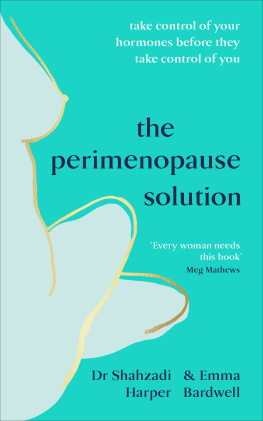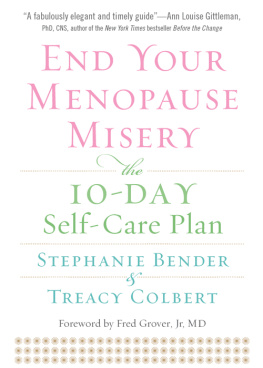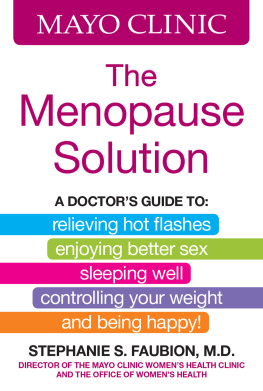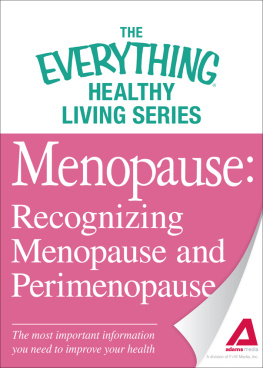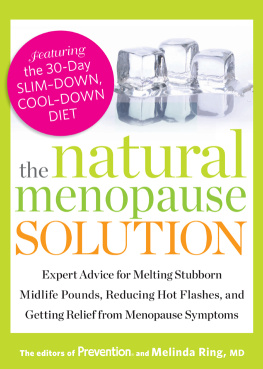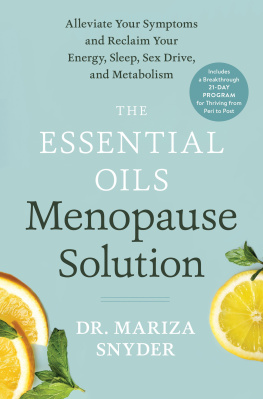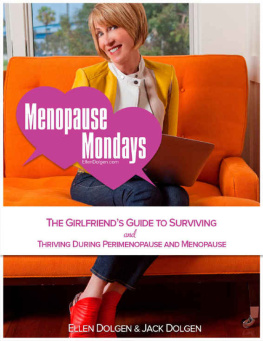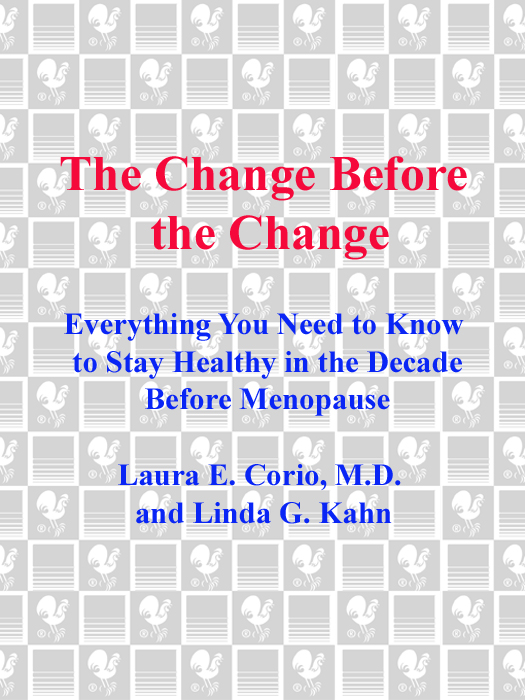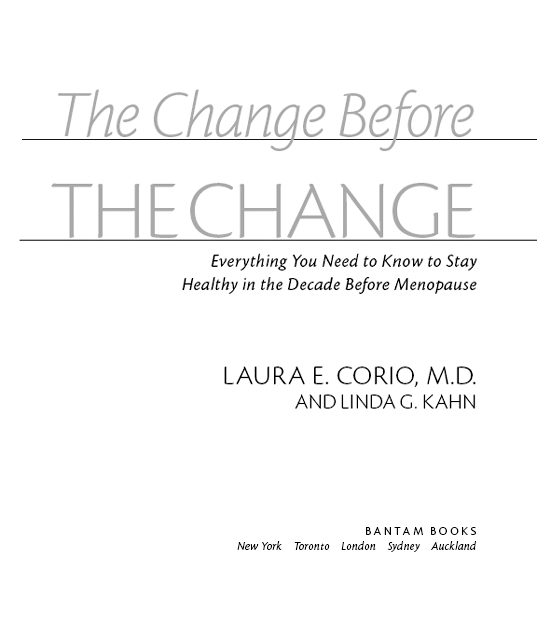Praise for
The Change Before
THE CHANGE
Women flourish when they are given state-of-the-art health information and a practical plan for putting it to work in their own lives. The Change Before the Change is a gift to midlife women everywhere.
Miriam Nelson, Ph.D., author of Strong Women Stay Young
Dr. Laura Corio is the gynecologist every woman should have in her corner. Written in her compassionate and friendly voice, The Change Before the Change is brimful with expert information and advice.
Adele Puhn, M.S.C.N.S., author of The 5-Day Miracle Diet
Dr. Corio integrates established medical wisdom with a savvy, holistic approach. She affirms as well as informs women who notice their bodies are changing even before laboratory tests confirm menopause is near.
Carol Birnbaum, M.D., Instructor in Psychiatry, Harvard Medical School
Every woman, no matter her age, needs this well-researched, informative, and readable book. More than a health plan for the years leading up to menopause, it is a primer for womens health throughout our life cycle.
Joan Borysenko, Ph.D., author of A Womans Book of Life
Dr. Corio captures the many concerns of women at a time of life that has lacked identity until now. How marvelous to have a physician who has listened.
Elizabeth Stewart, M.D., Brigham and Womens Hospital
This is a must-read that will change your life.
Dr. Richard Firshein, author of The Nutraceutical Revolution and Reversing Asthma

This edition contains the complete text of the original hardcover edition.
NOT ONE WORD HAS BEEN OMITTED.
THE CHANGE BEFORE THE CHANGE
PUBLISHING HISTORY
Bantam hardcover edition published November 2000 Bantam trade paperback edition / January 2002
All rights reserved.
Copyright 2000 by Laura E. Corio, M.D., and Linda G. Kahn. Book design by Casey Hampton.
Library of Congress Catalog Card Number: 00-31205.
No part of this book may be reproduced or transmitted in any form or by any means, electronic or mechanical, including photocopying, recording, or by any information storage and retrieval system, without permission in writing from the publisher. For information address: Bantam Books.
eISBN: 978-0-307-83043-2
Published simultaneously in the United States and Canada
Bantam Books are published by Bantam Books, a division of Random House, Inc. Its trademark, consisting of the words Bantam Books and the portrayal of a rooster, is Registered in U.S. Patent and Trademark Office and in other countries. Marca Registrada. Bantam Books, New York, New York.
v3.1
AUTHORS NOTE
Over the past two decades I have seen thousands of women through their perimenopausal years. Throughout this book, I have drawn on the stories they have generously shared with me to illustrate the vast range of symptoms and experiences that characterize this transition. Many of the case histories you will read are composites. When I have based examples on particular patients, I have changed their names and distinguishing features in order to protect their privacy.
At the end of each chapter of this book is a discussion of treatment options, including vitamins, minerals, foods, herbs, phytoestrogens, and hormone preparations that can be used to alleviate particular symptoms. These recommendations are not a prescription, and you should not implement any of these strategies without first consulting your physician. I have included them because I believe the best patient is an educated patientthe more informed you are, the better you will be able to collaborate with your doctor to come up with a treatment plan that suits your individual needs.
CONTENTS
LIST OF TABLES
LIST OF ILLUSTRATIONS
Changes in Body Shape
Healthy Bone in a 75-Year-Old Woman
Osteoporosis in a 47-Year-Old Woman
The Anatomy of a Healthy Breast
How to Examine Your Breasts
Types of Fibroids
INTRODUCTION
Woman to Woman
I love being a doctor. In particular, I love being a womens doctor. In twenty years as a board-certified physician specializing in obstetrics and gynecology, Ive seen thousands of patients, from teenagers to great-grandmothers. A typical day might include counseling one woman about getting pregnant and prescribing birth control for the next, figuring out why one patient is bleeding all the time and why another hasnt seen a period for months, treating some women for diseases and helping others avoid them, scanning bones, doing biopsies, and perhaps even delivering a baby or two. Whatever the immediate concern, I make it my business to spend time getting to know my patientsnot just their bodies, but their thoughts and feelings as welland explaining whats going on with them physically. Its my strong belief that understanding your own body and working with a doctor who understands you as a whole person are the keys to maintaining lifelong emotional, psychological, and physical well-being.
Back when I was a medical studentone of only 10 women in a class of 110topics such as PMS and menopause were simply not discussed. In fact, the entire concept of gender-specific medicine didnt yet exist. When we learned about heart disease, for example, all the information came from studies of men; it was assumed that womens bodies were the same, just smaller. In those days it didnt even cross my mind to question this exclusively male orientation. After all, I was expected to be one of the guys. What an awakening it was to encounter womens health issues in the flesh when I hung out my shingle and began practicing real medicine!
Ill never forget how, in those early days, a patient came in complaining of terrible premenstrual symptoms. I just nodded my head and took notes, although I hadnt a clue what to tell her. After hours, I ran to the medical library and read everything I could find on the subject. The next day I put together a PMS handout detailing vitamins and minerals to take and foods to avoid. Over the years Ive expanded this handout into an entire PMS-prevention plan.
Today, my focus has shifted to a new topic, one probably never dreamed aboutand certainly never spoken aboutby my medical school professors: perimenopause. About ten years ago I noticed that a lot of my patients in their forties were reporting similar symptoms: irregular bleeding, hot flashes, palpitations, mood swings, headaches, insomnia, memory loss, vaginal itching and dryness, lack of libido, dry skin and hair, weight gain. After a few years of these complaints, theyd come in and say, All done! Theyd stopped having their periods and had entered menopause. Clearly their bodies were going through a major transition in those years leading up to menopause. Once again, I hit the library. I discovered that contrary to the prevailing wisdom, which says that your hormones shift after menopause, serious hormone fluctuations take place long before you stop bleeding that can cause a multitude of often debilitating symptoms. In fact, most women find their symptoms are at their worst during perimenopause; after menopause they begin to feel better.


